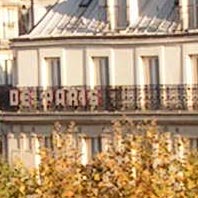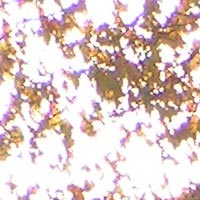Konica Minolta DiMAGE Z10
Review Date: November 29th 2004
|
Image Quality
All of the sample images in this Review were taken using the default 2048 x 1536 mode, which gives an average image size of around 1.2-1.6Mb.
Noise
There are 4 ISO settings available on the Konica Minolta DiMAGE Z10 which you can select at any time. Here are some 100% crops which show the noise levels for each ISO setting:
|
ISO 64 (100% crop) |
ISO 100 (100% crop) |
 |
 |
|
ISO 200 (100% crop) |
ISO 400 (100% crop) |
 |
 |
The noise levels look very good at ISO 50 and 100, with minimal noise starting to appear at ISO 200. Even ISO 400 doesn't exhibit too much noise, therefore making the Z10 useable in a variety of different lighting conditions. A very good performance from the Konica Minolta DiMAGE Z10.
Sharpening
Here are two 100% crops of images taken at the default Normal sharpening setting, which have been Saved as Web - Quality 50 in Photoshop. The right-hand image has had some sharpening applied in Photoshop. There are 3 sharpening levels that you can select on the Konica Minolta DiMAGE Z10 (Soft / Normal / Hard). I would either choose Hard and let the camera perform the sharpening for you, or set it to Soft and do it yourself in an application like Adobe Photoshop (giving you more control of the process).
|
Original 100% Crop |
Sharpened 100% Crop |
 |
 |
 |
 |
File Quality
The Konica Minolta DiMAGE Z10 has 3 different compression settings available, with Standard being the default option. Here are some 100% crops which show the quality of the various options, with the file size shown in brackets.
|
Fine (1.3Mb) |
Standard (0.65Mb) |
 |
 |
|
Economy (0.35Mb) |
|
 |
|
Chromatic Aberrations
The Konica Minolta DiMAGE Z10 handled chromatic aberrations quite well. A handful of images out of all the test images that I took exhibited some purple fringing, when the sun was either in or just outside the frame, as shown in the examples below. The camera controls the fringing to some extent when it does occur.
|
Example 1 |
Example 2 |
 |
 |
|
Example 3 |
Example 4 |
 |
 |
Macro
The Konica Minolta DiMAGE Z10 has an amazing Macro setting that allows you to focus on a subject that is just 1cm away from the camera. This can introduce other problems, such as the shadow of the camera getting in the picture and softness in some parts of the image if a large aperture is chosen by the camera.
|
Macro Shot (click to view full-sized image) |
100% Crop |
The first image shows how close you can get to the subject whilst still being able to auto-focus (in this case a compact flash card). The second image is a 100% crop.
Flash
The flash settings on the Konica Minolta DiMAGE Z10 are pretty standard - Auto/Forced/Off/Red-Eye Reduction/Slow Synchro. These shots of a white wall were taken at a distance of 1.5m.
|
Flash Off |
|
 |
|
|
Auto Flash - Wide Angle (37mm) |
Auto Flash - Telephoto (105mm) |
 |
 |
And here are some shots of yours truly. As you can see, the Flash On setting caused quite a large amount amount of red-eye, whilst the Red-Eye Reduction option almost completely removed it.
|
Flash On |
Flash On (100% Crop) |
 |
 |
|
Flash - Red-Eye Reduction |
Flash - Red-Eye Reduction (100% Crop) |
 |
 |
Night Shot
The Konica Minolta DiMAGE Z10 has a very respectable maximum shutter speed of 15 seconds, and even better a Timer mode which allows you to set a shutter speed up to 30 seconds. This is great news if you are seriously interested in night photography. I've included a 100% crop of the image to show what the quality is like. This shot was taken at a shutter speed of 15 seconds - notice the great traffic trails that you can record.
|
Night Shot (click to view full-sized image) |
100% Crop |
 |
|
Overall Image Quality
I wasn't expecting too much in terms of image quality from the Konica Minolta DiMAGE Z10, given its budget price of £150. Imagine my surprise then when the camera produced a great set of test images. The 3 megapixel images were a little soft at the default sharpening setting of Normal, but you can either choose the Hard setting or alternatively do some post-processing in an image editing program to make them sharper. Noise is very well controlled at all of the ISO settings, making the Konica Minolta DiMAGE Z10 suitable for a wide variety of lighting conditions, both indoor and out. The camera did exhibit some chromatic aberrations in high-contrast situations, but they were generally well controlled and not too noticeable. Macro performance was amazing, allowing you to focus just 1cm away from the subject. The night shot was very pleasing, with a maximum shutter speed of 15 seconds and even a bulb setting being very welcome. Using the flash indoors produced fairly good results, with the red-eye reduction mode working well. Only some evidence of chromatic aberrations spoiled an otherwise flawless performance from the Konica Minolta DiMAGE Z10.
|
 PhotographyBLOG is a member of the DIWA organisation. Our test results for the Konica Minolta DiMAGE Z10 have been submitted to DIWA for comparison with test results for different samples of the same camera model supplied by other DIWA member sites.
PhotographyBLOG is a member of the DIWA organisation. Our test results for the Konica Minolta DiMAGE Z10 have been submitted to DIWA for comparison with test results for different samples of the same camera model supplied by other DIWA member sites.



